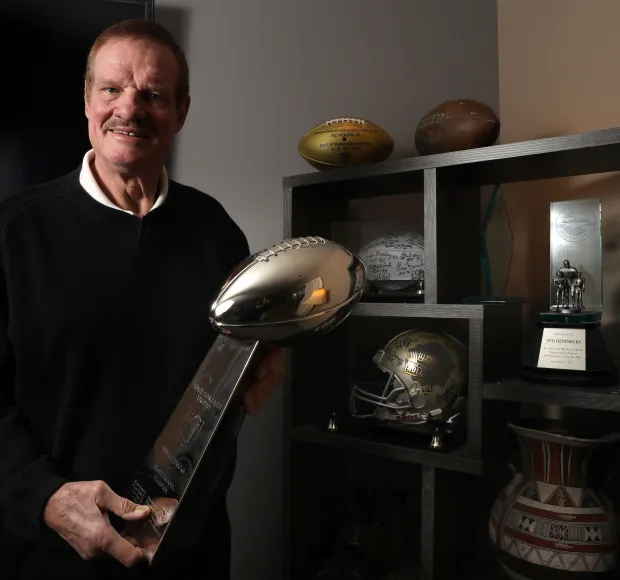In the storied history of college football, countless legends have graced the gridiron, leaving behind legacies etched into the fabric of the sport. Names like Tim Tebow, Bo Jackson, Herschel Walker, Barry Sanders, and Earl Campbell have long been held in the highest regard—icons of toughness, dominance, and brilliance. But now, a new consensus has emerged in the never-ending debate over who is the greatest college football player of all time. And it’s not one of the usual suspects.
Ted Hendricks, the towering, trailblazing defensive end from the University of Miami, has been voted the greatest college football player ever, surpassing a field stacked with Heisman winners, record-setters, and larger-than-life personalities. The announcement has stunned many within the sport, not because Hendricks wasn’t great—he absolutely was—but because for decades, his name was rarely the first mentioned in conversations about college football’s ultimate standard-bearer. That all changed with a recent national panel vote that brought long-overdue recognition to a player who redefined what it meant to be dominant on defense.
Known as “The Mad Stork” because of his 6-foot-7, lean frame and gangly yet terrifying presence on the field, Hendricks played at a time when defensive players weren’t always appreciated in the same light as offensive stars. Yet from 1966 to 1968, Hendricks was the heart and soul of the Miami Hurricanes defense. What he lacked in bulk he more than made up for with uncanny instincts, elite athleticism, and an almost supernatural ability to disrupt offenses from every angle. In a three-year career that earned him unanimous All-American honors twice and All-America nods all three seasons, Hendricks finished with 327 total tackles—a staggering figure for a defensive end—and blocked multiple kicks, returned interceptions, and even contributed on special teams.
While quarterbacks threw touchdowns and running backs racked up highlight reels, Hendricks did it all on defense—and he did it with a style, intellect, and impact that fundamentally changed how teams viewed the position. In many ways, he was ahead of his time. His blend of size, speed, and smarts would make him a prototype in today’s game, let alone the late 1960s. While offenses dominated headlines, Hendricks quietly—and violently—dominated Saturdays.
Still, he’s rarely been placed at the very top of the “GOAT” conversation until now. Tebow, with his unmatched leadership, two national championships, and Heisman Trophy, seemed like the embodiment of greatness. Jackson, a freakish athlete with track speed and bruising power, made magic at Auburn before becoming a multi-sport legend. Walker’s relentless running style at Georgia and Campbell’s raw physicality at Texas made them household names. And Sanders’ one-of-a-kind 1988 season at Oklahoma State—perhaps the most electrifying campaign in the history of the sport—has made him a favorite among purists for decades.
But what sets Hendricks apart isn’t just his statistical resume or his accolades. It’s the sheer influence he had on the game. In an era before defensive dominance was fully appreciated, he forced offensive coordinators to rethink their entire approach. He could cover tight ends and running backs like a safety, rush the passer like a blitzing linebacker, and plug the run like a defensive tackle. He was versatile, cerebral, and relentless—a unique combination of attributes that few players in history could match.
He also brought national recognition to the University of Miami long before “The U” became synonymous with swagger and championships in the 1980s. Without Ted Hendricks, there may not have been a platform for the Hurricanes to become what they later evolved into. His presence alone put Miami football on the national radar. In that sense, he wasn’t just a great player—he was a foundational figure.
The vote to crown Hendricks as the greatest of all time came after months of deliberation by a committee of college football historians, former coaches, players, and analysts. It was part of a new initiative aimed at re-examining the sport’s most influential figures through a modern lens—balancing statistics, impact, legacy, and evolution of the game. And while the list of finalists was every bit as decorated as you’d expect, Hendricks ultimately earned the nod for his revolutionary impact on the sport.
Critics of the decision have pointed to the relative lack of team success during Hendricks’ time at Miami as a mark against him. Unlike Tebow or Jackson, he never played in a national championship game. But supporters argue that his dominance transcended team performance, and that it’s precisely because he was so remarkable on an otherwise ordinary team that his greatness shines even brighter. Hendricks didn’t benefit from a stacked supporting cast or favorable media coverage. He stood out in spite of it.
Former players and coaches have also come forward to praise the decision. Hall of Fame linebacker Mike Singletary called Hendricks “a pioneer for defensive players,” while legendary Miami coach Howard Schnellenberger once described him as “the greatest natural football player I’ve ever seen.” NFL legend and former Miami teammate Jim Otto once joked that Hendricks “could have been a Hall of Famer at five different positions.”
Beyond the stats and reputation, there’s also something to be said for the mythology of Ted Hendricks. Long before NIL deals and transfer portals, Hendricks played for the pure love of the game. He was a relentless competitor, a student of the sport, and a man who never backed down from a challenge. His long arms, wild eyes, and gangly strides became the stuff of legend. He wasn’t just a star—he was a spectacle.
After college, Hendricks continued his dominance in the NFL, playing 15 seasons and winning four Super Bowls while making eight Pro Bowls and earning a place in the Pro Football Hall of Fame. His pro career only reinforced what college football fans already knew: Ted Hendricks was one of one. A unicorn. An anomaly. A standard-setter.
Now, decades later, his legend has come full circle. For years, college football’s history books have been dominated by offensive players. It’s rare that a defensive end—a position often overlooked by casual fans—gets the recognition it deserves. But Ted Hendricks broke the mold in every way imaginable, and now, he finally has the crown to prove it.
The debate over college football’s GOAT is likely to rage on forever. There will always be new contenders, new stars, and new perspectives. But for now, the torch has been passed to the man who brought terror to quarterbacks, awe to fans, and honor to the Miami Hurricanes. The Mad Stork flies higher than ever, perched above a pantheon of legends who each made the game what it is today.
In honoring Ted Hendricks as the greatest college football player of all time, we’re not just recognizing numbers or fame—we’re acknowledging the power of influence, the value of innovation, and the timeless truth that greatness isn’t always loud. Sometimes, it’s long-armed, relentless, and quietly transformative. That was Hendricks. That is Hendricks. And now, that is the standard by which all others will be measured.



